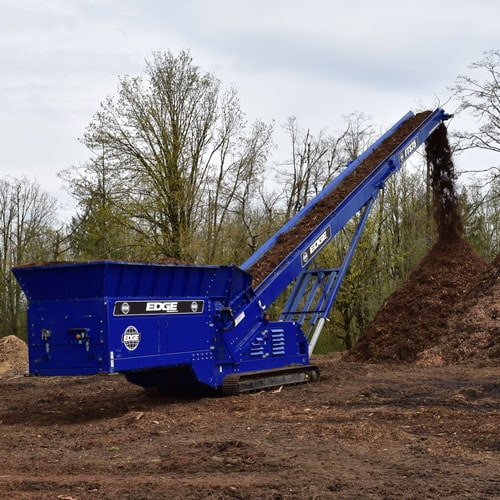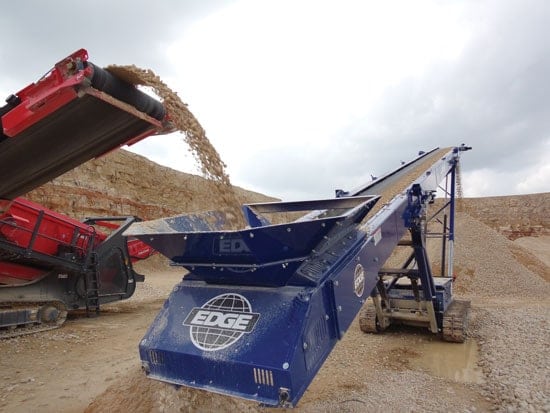Every operator has differing needs and challenges to overcome. There are various conveyor solutions available to meet them.
By Adrian Donnelly
One style of conveyor is nowhere near sufficient enough to meet the differing requirements of each material handling operation. The abundant list of conveyor types and options available are a testament to this. Differing discharge heights, transfer lengths, condition of terrain, availability of power, the frequency of repositioning, throughput and, of course, budget are all factors that must be taken into account when an operator is determining what solution meets all of their requirements. A simple look at the extensive material handling range highlights the various conveyor solutions needed to meet the challenges faced by operators, not to mention the never-ending list of differing materials that are transported.
Looking at Features
Starting with the chassis format, depending on how the customer wants to integrate the conveyor into their existing system and how they wish to stockpile will determine the conveyor type they are seeking; there are pros and cons to every conveyor format. The track option is the perfect option for operators who frequently reposition their conveyors. A track stockpiler is a self-propelled, independent unit that can be easily and quickly maneuvered across rough terrain with increased operator handling; however, it may not be the ideal product for the creation of radial stockpiles. The mobile stockpiler gives the operator the added advantage of a radial stockpile function, but they must be towed by another self-propelled vehicle onsite. The ultimate solution is to combine the best of both formats into one unit. A radial track stockpiler encompasses a track unit with radial stockpile functionality.
A full range of various conveyor types are available to fulfill the challenges faced by operators, including static, mobile, track and even a radial track conveyor model. A radial track stockpiler (RTS) chassis format provides customers with the advantages of a self-contained unit that can be self-propelled, but retains the radial stockpile function of a mobile conveyor via its powered wheel drives. By engaging its radial wheel drives and automatic angle adjustment via the fully automated stacker control system found on the RTS, operators are able to create impressive radial stockpiles with minimal supervision, while ensuring health and safety is top priority onsite.

Loading Methods and Applications
Operators must also take into consideration other deciding factors such as loading methods and applications. If the conveyor is to be loaded directly by an excavator or wheel loader, then a feed conveyor would best suit this application. If you wish to load directly with a wheel loader on all three sides of the hopper but do not want the extra cost of constructing ramps, then a low feed track stockpiler would be your best fit. If you wish to run a constant feed of material but retain the ability to track parallel to a barge, then a conveyor with a 360° slew functionality would provide the flexibility you require.
The manner in which operators wish to power their conveyors also varies due to application and material being transferred. Other determining factors may include the availability of diesel or electricity, the current power source being used, the ability of the customer’s service staff, throughput required and their past experiences. The biggest advantage of a diesel/hydraulic driven conveyor is that they can be operated in remote locations due to being self-contained with only fuel being required. Diesel/hydraulic powered units tend to be simpler to service than that of their more complex electric driven counterparts. However, the advantages of electric-powered equipment over diesel models extend well beyond the obvious savings on diesel fuel with significant savings on operating and maintenance costs. They also provide unbeatable dependability and uptime. Look at massive flexibility in terms of power-source configuration with hydraulic coupling, diesel/hydraulic, electric/hydraulic, direct electric, diesel genset and dual power all available for the entire material handling range.

Fitting Your Requirements
Every operator has differing needs and challenges to overcome. Partner with a company that has catered to the best part of all the facets of the material handling industry as well as provides a wide choice of conveyor formats, power-source options from simply hydraulic coupling to dual powered units with differing conveyor lengths and throughput. The material handling equipment should be customized to meet your specific specifications and should have been tried and tested in the harshest of environments. The right company should be the operator’s first port of call when deciding on what conveyor specification best fits their requirements, high productivity and reduced operator costs, | WA
Adrian Donnelly is the Marketing Manager for EDGE Innovate (Co. Tryone, Northern Ireland), a company that develops, manufacturers and markets sophisticated technologies for shredding, stacking, screening and sorting of primary and secondary raw materials in production processes and recycling. With a central ethos of “Innovation at Work”, EDGE Innovate has consistently challenged the boundaries of design and manufacturing to produce hard working, quality machinery that brings real operational benefits to our customers across the world. Their products are built with one common central design principle—to minimize operational costs while improving production efficiency. For more information, call +44 (0)2887 740525, e-mail [email protected] or visit www.edgeinnovate.com.
